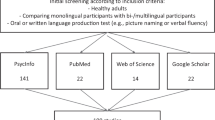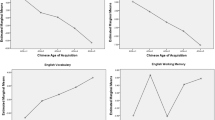Abstract
The present research tested the hypothesis that the age at which one’s first language (L1) words are learned influences language processing in bilinguals. Prior research on bilingual language processing by Kroll and colleagues has suggested that memory links between L1 words and conceptual representations are stronger than memory links between one’s second language (L2) word and conceptual representations. We hypothesized that the strengths of memory links between L1 words and conceptual representations are stronger for words learned early in life than for words learned later in life. Support for the hypothesis was obtained in bilingual translation experiment with 36 Spanish–English bilinguals. Participants translated L1 words into L2 and L2 words into L1. Half of the L1 words were learned early in childhood (early AoA words), and half were learned later in life (late AoA words). The L2 words were translation equivalents of the L1 words tested; the average age at which L2 words were learned was age 7. Target words were presented either in random order or blocked by semantic category. Translation times were longer when trials were blocked by semantic category (i.e., categorical interference) occurred only when early AoA L1 words were translated into L2. Implications for current models of bilingual memory are discussed.
Similar content being viewed by others
References
Altarriba J., Mathis K. (1997) Conceptual and lexical development in second language acquisition. Journal of Memory and Language 36: 550–568
Brown G., Watson F. (1987) First in, first out: Word learning age and spoken word frequency as predictors of word familiarity and word naming latency. Memory and Cognition 15: 208–216
Brysbaert M., Van Wijnendaele I., De Deyne S. (2000) Age of acquisition effects in semantic processing tasks. Acta Psychologica 104: 215–226
Cheung H., Chen H. (1998) Lexical and conceptual processing in Chinese–English bilinguals: Further evidence for asymmetry. Memory and Cognition 26: 1002–1013
Clark H. H. (1973) The language-as-fixed-effect fallacy: A critique of language statistics in psychological research. Journal of Verbal Learning and Verbal Behavior 12: 335–359
Damian M., Vigliocco G., Levelt W. (2001) Effects of semantic context in the naming of pictures and words. Cognition 81: B77–B86
De Groot A. (1992) Determinants of word translation. Journal of Experimental Psychology: Learning Memory and Cognition 18: 1001–1018
De Groot A, Kroll J. (1997) Tutorials in Bilingualism: Psycholinguistic perspectives. Erlbaum, Mahwah, NJ
Dijkstra T., Van Heuven W. (1998) The BIA model and bilingual word recognition. In: Grainger J., Jacobs A. (eds) Localist connectionist approaches to human cognition. Lawrence Erlbaum Associates, Mahwah, NJ, pp 189–225
Duyck W., Brysbaert M. (2002) What number translation studies can teach us about the lexico-semantic organization in bilinguals. Psychologica Beligica 42: 151–175
Ellis A. W., Morrison C. M. (1998) Real age of acquisition effects in lexical retrieval. Journal of Experimental Psychology: Learning, Memory, and Cognition 24: 515–523
Fox E. (1996) Cross-Language priming form ignored words: Evidence for a common representational system in bilinguals. Journal of Memory and Language 35: 353–370
Francis W. N., Kučera H. (1982) Frequency analysis of English usage: Lexicon and grammar. Houghton Mifflin, Boston
Ghyselinck M., Custer R., Brysbaert M. (2004) The effect of age of acquisition in visual word processing: Further evidence for the semantic hypothesis. Journal of Experimental Psychology: Learning, Memory, and Cognition 30: 550–554
Gilhooly K., Gilhooly M. (1979) Age of acquisition effects in lexical decision and episodic memory tasks. Memory and Cognition 7: 214–223
Gilhooly K., Logie R. (1980) Age of acquisition, imager, concreteness, familiarity, and ambiguity measures for 1,944 words. Behavior, Research Methods, and Instrumentation 12: 395–427
Green D. (1998) Mental control of the bilingual lexico-semantic system. Bilingualism: Language and Cognition 1: 67–81
Grosjean F. (1997) Processing mixed language: Issues, findings, and model. In: Groot A. M., Kroll J. F. (eds) Tutorials in Bilingualism: Psycholinguistic perspectives. Erlbaum, Mahwah, NJ, pp 225–254
Habuchi Y. (2003) Word processing in cross-language translation between Japanese and English by advanced second-language learners: A test of the revised hierarchical model. Japanese Journal of Educational Psychology 51: 65–75
Hernandez A. E., Li P. (2007) Age of acquisition effects: Its neural and computational mechanisms. Psychological Bulletin 133: 638–650
Hirsh K., Morrison C., Gaset S., Carnicer E. (2003) Age of acquisition and speech production in L2. Bilingualism: Language and Cognition 6: 117–128
Izura C., Ellis A. (2004) Age of acquisition effects in translation judgment tasks. Journal of Memory and Language 50: 165–181
Juhasz B. J. (2005) Age of acquisition effects in word and picture identification. Psychological Bulletin 131: 684–712
Juhasz B. J., Rayner K. (2003) Investigating the effects of a set of intercorrelated variables on eye fixation durations in reading. Journal of Experimental Psychology: Learning, Memory, and Cognition 29: 1312–1318
Keatley C., Spinks J., Degelder B. (1994) Asymmetrical cross-language priming effects. Memory and Cognition 22: 70–84
Kroll J., Curley J. (1988) Lexical memory in novice bilinguals: The role of concepts in retrieving second language words. In: Gruneberg M., Morris P., Sykes R. (eds) Practical aspects of memory. Wiley, London
Kroll, J. F., & De Groot, A. M .B. (1997). Lexical and conceptual memory in the bilingual: Mapping form to meaning in two languages. In A. M. B. de Groot & J. F. Kroll (Eds.), Tutorials in bilingualism: Psycholinguistic perspectives (pp. 169–199). Mahwah, NJ: Erlbaum.
Kroll K., Stewart E. (1994) Category interference in translation and picture naming: Evidence for asymmetric connection between bilingual memory representations. Journal of Memory and Language 33: 149–174
Heij W., Hooglander A., Kerling R., Van Der Velden E. (1996) Nonverbal context effects in forward and backward word translation: Evidence for concept mediation. Journal of Memory and Language 35: 648–665
Lewis M.B., Gerhand S., Ellis H.D. (2001) Re-evaluating age-of-acquisition effects: Are they simply cumulative-frequency effects?. Cognition 78: 189–205
Li P., Zhao X., MacWhinney B. (2007) Dynamic self-organization and early lexical development in children. Cognitive Science 31: 581–612
Morrison C., Ellis A. (1995) Roles of word frequency and age of acquisition in word naming and lexical decision. Journal of Experimental Psychology: Learning Memory, and Cognition 21: 116–133
Morrison C. M., Ellis A. W. (2000) Real age of acquisition effects in word naming and lexical decision. British Journal of Psychology 91: 167–180
Morrison C. M., Ellis A. W., Quinlan P. T. (1992) Age of acquisition, not word frequency, affect object naming, not object recognition. Memory and Cognition 20: 705–714
Morrison C. M., Hirsh K., Chappell T., Ellis A. (2002) Age and age of acquisition: An evaluation of the cumulative frequency hypothesis. European Journal of Cognitive Psychology 14: 435–459
Murray D. J. (1986) Characteristics of words determining how easily they will be translated into a second language. Applied Psycholinguistics 7: 353–372
Schneidner W., Eschman A., Zuccolotto A. (2002) E-Prime user’s guide. Psychology Software Tools, Inc, Pittsburg
Sebastián-Gallés N., Cuetos-Vega F., Carreiras-Valiña M., Martí-Antonin M. (2000) LEXESP. Léxico informatizado del español CD-ROM. Universidad de Barcelona, Barcelona
Sholl A., Sankaranarayanan A., Kroll J. (1995) Transfer between picture naming and translation: A test of asymmetries in bilingual memory. Psychological Science 6: 45–49
Stadthagen-Gonzalez H., Bowers J., Damian M. (2004) Age of acquisition effects in visual words recognition: Evidence from expert vocabularies. Cognition 93: B11–B26
Steyvers M., Tenenbaum J. B. (2005) The large-scale structure of semantic networks: Statistical analyses and a model of semantic growth. Cognitive Science 29: 41–78
Zevin J., Seidenberg M. (2002) Age of acquisition effects in word reading and other tasks. Journal of Memory and Language 27: 1–29
Author information
Authors and Affiliations
Corresponding author
Additional information
The research was conducted in partial completion of a master’s of science degree in the Department of Psychology at Oklahoma State University.
Rights and permissions
About this article
Cite this article
Bowers, J.M., Kennison, S.M. The Role of Age of Acquisition in Bilingual Word Translation: Evidence from Spanish-English Bilinguals. J Psycholinguist Res 40, 275–289 (2011). https://doi.org/10.1007/s10936-011-9169-z
Published:
Issue Date:
DOI: https://doi.org/10.1007/s10936-011-9169-z




